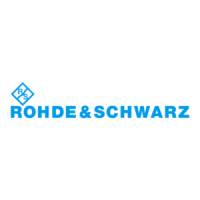GUI reference
R&S
®
ZNA
412User Manual 1178.6462.02 ─ 20
Phase/El Length
Displays or hides the phase delay ("Phs Dly") and the electrical length ("El Len") of the
trace in the selected evaluation range ("Evaluation Range..."). The parameters are only
available for trace formats that contain phase information, i.e. for the formats "Phase",
"Unwr Phase", and the polar diagram formats "Polar", "Smith", "Inv Smith" (see Chap-
ter 5.3, "Format softtool", on page 374). Moreover, the sweep type must be a fre-
quency sweep, and the evaluation range must contain at least 3 measurement points.
The phase parameters are obtained from an approximation to the derivative of the
phase in the selected evaluation range.
●
"Phs Dly" is the phase delay, which is an approximation to the group delay and cal-
culated as follows:
f
PD
deg
360
where Δf is the width of the evaluation range and ΔΦ is the corresponding phase
change. See also note on transmission and reflection parameters below.
●
"El Len" is the electrical length, which is the product of the phase delay times the
speed of light in the vacuum.
If no dispersion occurs, the phase delay is equal to the group delay. For more informa-
tion, refer to Chapter 4.3.8, "Delay, aperture, electrical length", on page 140.
Note: To account for the propagation in both directions, delay and electrical length of a
reflection parameter are only half the delay and electrical length of a transmission
parameter. The formula for PD above is for transmission parameters. See the section
on "Length and delay measurement" in Chapter 4.6.1.3, "Auto Length", on page 202.
Tip: The phase evaluation can cause misleading results if the evaluation range con-
tains a 360 deg phase jump. The trace format "Unwr Phase" avoids this behavior.
Remote command:
CALCulate<Chn>:STATistics:EPDelay[:STATe]
CALCulate<Chn>:STATistics:RESult?
CALCulate<Chn>:STATistics[:STATe]
Flatness/Gain/Slope
Displays or hides trace parameters that the analyzer calculates for the selected evalua-
tion range ("Evaluation Range...").
Suppose that A and B denote the trace points at the beginning and at the end of the
evaluation range, respectively.
●
"Gain" is the larger of the two stimulus values of points A and B.
●
"Slope" is the difference of the stimulus values of point B minus point A.
●
"Flatness" is a measure of the deviation of the trace in the evaluation range from
linearity. The analyzer calculates the difference trace between the active trace and
Traces softtool

